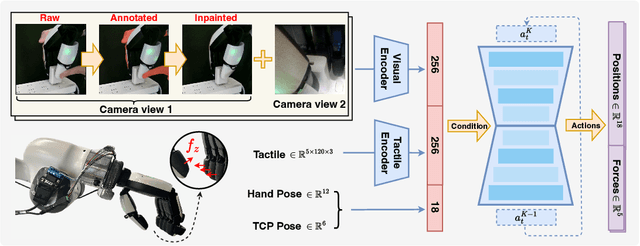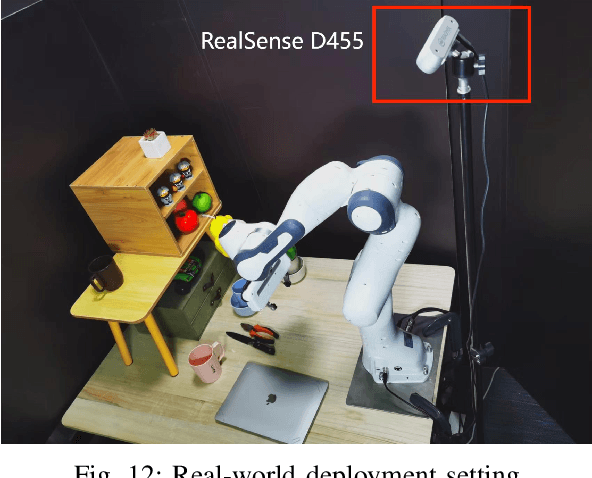Chuan Wen
ARMADA: Autonomous Online Failure Detection and Human Shared Control Empower Scalable Real-world Deployment and Adaptation
Oct 02, 2025Abstract:Imitation learning has shown promise in learning from large-scale real-world datasets. However, pretrained policies usually perform poorly without sufficient in-domain data. Besides, human-collected demonstrations entail substantial labour and tend to encompass mixed-quality data and redundant information. As a workaround, human-in-the-loop systems gather domain-specific data for policy post-training, and exploit closed-loop policy feedback to offer informative guidance, but usually require full-time human surveillance during policy rollout. In this work, we devise ARMADA, a multi-robot deployment and adaptation system with human-in-the-loop shared control, featuring an autonomous online failure detection method named FLOAT. Thanks to FLOAT, ARMADA enables paralleled policy rollout and requests human intervention only when necessary, significantly reducing reliance on human supervision. Hence, ARMADA enables efficient acquisition of in-domain data, and leads to more scalable deployment and faster adaptation to new scenarios. We evaluate the performance of ARMADA on four real-world tasks. FLOAT achieves nearly 95% accuracy on average, surpassing prior state-of-the-art failure detection approaches by over 20%. Besides, ARMADA manifests more than 4$\times$ increase in success rate and greater than 2$\times$ reduction in human intervention rate over multiple rounds of policy rollout and post-training, compared to previous human-in-the-loop learning methods.
TimeRewarder: Learning Dense Reward from Passive Videos via Frame-wise Temporal Distance
Sep 30, 2025Abstract:Designing dense rewards is crucial for reinforcement learning (RL), yet in robotics it often demands extensive manual effort and lacks scalability. One promising solution is to view task progress as a dense reward signal, as it quantifies the degree to which actions advance the system toward task completion over time. We present TimeRewarder, a simple yet effective reward learning method that derives progress estimation signals from passive videos, including robot demonstrations and human videos, by modeling temporal distances between frame pairs. We then demonstrate how TimeRewarder can supply step-wise proxy rewards to guide reinforcement learning. In our comprehensive experiments on ten challenging Meta-World tasks, we show that TimeRewarder dramatically improves RL for sparse-reward tasks, achieving nearly perfect success in 9/10 tasks with only 200,000 interactions per task with the environment. This approach outperformed previous methods and even the manually designed environment dense reward on both the final success rate and sample efficiency. Moreover, we show that TimeRewarder pretraining can exploit real-world human videos, highlighting its potential as a scalable approach path to rich reward signals from diverse video sources.
EfficientVLA: Training-Free Acceleration and Compression for Vision-Language-Action Models
Jun 11, 2025Abstract:Vision-Language-Action (VLA) models, particularly diffusion-based architectures, demonstrate transformative potential for embodied intelligence but are severely hampered by high computational and memory demands stemming from extensive inherent and inference-time redundancies. While existing acceleration efforts often target isolated inefficiencies, such piecemeal solutions typically fail to holistically address the varied computational and memory bottlenecks across the entire VLA pipeline, thereby limiting practical deployability. We introduce EfficientVLA, a structured and training-free inference acceleration framework that systematically eliminates these barriers by cohesively exploiting multifaceted redundancies. EfficientVLA synergistically integrates three targeted strategies: (1) pruning of functionally inconsequential layers from the language module, guided by an analysis of inter-layer redundancies; (2) optimizing the visual processing pathway through a task-aware strategy that selects a compact, diverse set of visual tokens, balancing task-criticality with informational coverage; and (3) alleviating temporal computational redundancy within the iterative diffusion-based action head by strategically caching and reusing key intermediate features. We apply our method to a standard VLA model CogACT, yielding a 1.93X inference speedup and reduces FLOPs to 28.9%, with only a 0.6% success rate drop in the SIMPLER benchmark.
KineDex: Learning Tactile-Informed Visuomotor Policies via Kinesthetic Teaching for Dexterous Manipulation
May 04, 2025



Abstract:Collecting demonstrations enriched with fine-grained tactile information is critical for dexterous manipulation, particularly in contact-rich tasks that require precise force control and physical interaction. While prior works primarily focus on teleoperation or video-based retargeting, they often suffer from kinematic mismatches and the absence of real-time tactile feedback, hindering the acquisition of high-fidelity tactile data. To mitigate this issue, we propose KineDex, a hand-over-hand kinesthetic teaching paradigm in which the operator's motion is directly transferred to the dexterous hand, enabling the collection of physically grounded demonstrations enriched with accurate tactile feedback. To resolve occlusions from human hand, we apply inpainting technique to preprocess the visual observations. Based on these demonstrations, we then train a visuomotor policy using tactile-augmented inputs and implement force control during deployment for precise contact-rich manipulation. We evaluate KineDex on a suite of challenging contact-rich manipulation tasks, including particularly difficult scenarios such as squeezing toothpaste onto a toothbrush, which require precise multi-finger coordination and stable force regulation. Across these tasks, KineDex achieves an average success rate of 74.4%, representing a 57.7% improvement over the variant without force control. Comparative experiments with teleoperation and user studies further validate the advantages of KineDex in data collection efficiency and operability. Specifically, KineDex collects data over twice as fast as teleoperation across two tasks of varying difficulty, while maintaining a near-100% success rate, compared to under 50% for teleoperation.
FP3: A 3D Foundation Policy for Robotic Manipulation
Mar 11, 2025Abstract:Following its success in natural language processing and computer vision, foundation models that are pre-trained on large-scale multi-task datasets have also shown great potential in robotics. However, most existing robot foundation models rely solely on 2D image observations, ignoring 3D geometric information, which is essential for robots to perceive and reason about the 3D world. In this paper, we introduce FP3, a first large-scale 3D foundation policy model for robotic manipulation. FP3 builds on a scalable diffusion transformer architecture and is pre-trained on 60k trajectories with point cloud observations. With the model design and diverse pre-training data, FP3 can be efficiently fine-tuned for downstream tasks while exhibiting strong generalization capabilities. Experiments on real robots demonstrate that with only 80 demonstrations, FP3 is able to learn a new task with over 90% success rates in novel environments with unseen objects, significantly surpassing existing robot foundation models.
Predictive Inference With Fast Feature Conformal Prediction
Dec 01, 2024Abstract:Conformal prediction is widely adopted in uncertainty quantification, due to its post-hoc, distribution-free, and model-agnostic properties. In the realm of modern deep learning, researchers have proposed Feature Conformal Prediction (FCP), which deploys conformal prediction in a feature space, yielding reduced band lengths. However, the practical utility of FCP is limited due to the time-consuming non-linear operations required to transform confidence bands from feature space to output space. In this paper, we introduce Fast Feature Conformal Prediction (FFCP), which features a novel non-conformity score and is convenient for practical applications. FFCP serves as a fast version of FCP, in that it equivalently employs a Taylor expansion to approximate the aforementioned non-linear operations in FCP. Empirical validations showcase that FFCP performs comparably with FCP (both outperforming the vanilla version) while achieving a significant reduction in computational time by approximately 50x. The code is available at https://github.com/ElvisWang1111/FastFeatureCP
Data Scaling Laws in Imitation Learning for Robotic Manipulation
Oct 24, 2024Abstract:Data scaling has revolutionized fields like natural language processing and computer vision, providing models with remarkable generalization capabilities. In this paper, we investigate whether similar data scaling laws exist in robotics, particularly in robotic manipulation, and whether appropriate data scaling can yield single-task robot policies that can be deployed zero-shot for any object within the same category in any environment. To this end, we conduct a comprehensive empirical study on data scaling in imitation learning. By collecting data across numerous environments and objects, we study how a policy's generalization performance changes with the number of training environments, objects, and demonstrations. Throughout our research, we collect over 40,000 demonstrations and execute more than 15,000 real-world robot rollouts under a rigorous evaluation protocol. Our findings reveal several intriguing results: the generalization performance of the policy follows a roughly power-law relationship with the number of environments and objects. The diversity of environments and objects is far more important than the absolute number of demonstrations; once the number of demonstrations per environment or object reaches a certain threshold, additional demonstrations have minimal effect. Based on these insights, we propose an efficient data collection strategy. With four data collectors working for one afternoon, we collect sufficient data to enable the policies for two tasks to achieve approximately 90% success rates in novel environments with unseen objects.
Can Transformers Capture Spatial Relations between Objects?
Mar 01, 2024Abstract:Spatial relationships between objects represent key scene information for humans to understand and interact with the world. To study the capability of current computer vision systems to recognize physically grounded spatial relations, we start by proposing precise relation definitions that permit consistently annotating a benchmark dataset. Despite the apparent simplicity of this task relative to others in the recognition literature, we observe that existing approaches perform poorly on this benchmark. We propose new approaches exploiting the long-range attention capabilities of transformers for this task, and evaluating key design principles. We identify a simple "RelatiViT" architecture and demonstrate that it outperforms all current approaches. To our knowledge, this is the first method to convincingly outperform naive baselines on spatial relation prediction in in-the-wild settings. The code and datasets are available in \url{https://sites.google.com/view/spatial-relation}.
General Flow as Foundation Affordance for Scalable Robot Learning
Jan 21, 2024



Abstract:We address the challenge of acquiring real-world manipulation skills with a scalable framework.Inspired by the success of large-scale auto-regressive prediction in Large Language Models (LLMs), we hold the belief that identifying an appropriate prediction target capable of leveraging large-scale datasets is crucial for achieving efficient and universal learning. Therefore, we propose to utilize flow, which represents the future trajectories of 3D points on objects of interest, as an ideal prediction target in robot learning. To exploit scalable data resources, we turn our attention to cross-embodiment datasets. We develop, for the first time, a language-conditioned prediction model directly from large-scale RGBD human video datasets. Our predicted flow offers actionable geometric and physics guidance, thus facilitating stable zero-shot skill transfer in real-world scenarios.We deploy our method with a policy based on closed-loop flow prediction. Remarkably, without any additional training, our method achieves an impressive 81% success rate in human-to-robot skill transfer, covering 18 tasks in 6 scenes. Our framework features the following benefits: (1) scalability: leveraging cross-embodiment data resources; (2) universality: multiple object categories, including rigid, articulated, and soft bodies; (3) stable skill transfer: providing actionable guidance with a small inference domain-gap. These lead to a new pathway towards scalable general robot learning. Data, code, and model weights will be made publicly available.
Any-point Trajectory Modeling for Policy Learning
Dec 28, 2023



Abstract:Learning from demonstration is a powerful method for teaching robots new skills, and more demonstration data often improves policy learning. However, the high cost of collecting demonstration data is a significant bottleneck. Videos, as a rich data source, contain knowledge of behaviors, physics, and semantics, but extracting control-specific information from them is challenging due to the lack of action labels. In this work, we introduce a novel framework, Any-point Trajectory Modeling (ATM), that utilizes video demonstrations by pre-training a trajectory model to predict future trajectories of arbitrary points within a video frame. Once trained, these trajectories provide detailed control guidance, enabling the learning of robust visuomotor policies with minimal action-labeled data. Our method's effectiveness is demonstrated across 130 simulation tasks, focusing on language-conditioned manipulation tasks. Visualizations and code are available at: \url{https://xingyu-lin.github.io/atm}.
 Add to Chrome
Add to Chrome Add to Firefox
Add to Firefox Add to Edge
Add to Edge